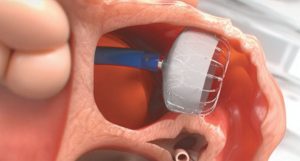 The WATCHMAN FLX™ Left Atrial Appendage Closure (LAAC) Implant provides an alternative for patients with atrial fibrillation who take warfarin on a long-term basis to help prevent blood clots and possible stroke. The implant acts as a safety net by closing off the left atrial appendage (LAA) and catching harmful blood clots before they enter the bloodstream.
The WATCHMAN FLX™ Left Atrial Appendage Closure (LAAC) Implant provides an alternative for patients with atrial fibrillation who take warfarin on a long-term basis to help prevent blood clots and possible stroke. The implant acts as a safety net by closing off the left atrial appendage (LAA) and catching harmful blood clots before they enter the bloodstream.
The LAAC device is inserted through a catheter in the femoral vein in the groin and guided into the patient’s heart, which can filter potential blood clots and prevent possible stroke. The LAAC device can be used to treat arrhythmia and atrial fibrillation.
After FDA approval in 2015, Dr. Daniel Friedman and his partners were the first in the area to offer the Watchman Device to patients. Since then, the Bradenton Cardiology Center has implanted more than 1200 Watchman Devices and is the largest Watchman facility in not only Florida, but nationwide. Dr. Friedman himself performs the procedure on average 130 times per year.
Arrhythmia
Also called an irregular heartbeat, arrhythmia is a problem with the rate or rhythm of the heart. It could be beating too quickly, too slowly, or with an irregular pattern. Atrial fibrillation is the most common form of arrhythmia and causes an irregular and fast heartbeat.
People with arrhythmia may experience many symptoms including dizziness, chest pain, shortness of breath, and sweating. Arrhythmias are diagnosed using a range of tests, including Holter and event monitors, electrocardiograms, stress testing, and electrophysiology studies.
Atrial Fibrillation
To understand atrial fibrillation, you must understand the heart’s normal rhythm. The heart pumps blood to the rest of the body. During each heartbeat, the two upper chambers of the heart (atria) contract, followed by the two lower chambers (ventricles). These actions, when timed perfectly, allow for an efficient pump. The heart’s electrical system directs the timing of the heart’s contractions.
The electrical impulse begins in the sinoatrial (SA node) in the right atrium. Typically, the SA node adjusts the rate of impulses depending on the person’s activity. For example, the SA node increases the rate of impulses during exercise and decreases the rate of impulses during sleep.
When the SA node fires an impulse, electrical activity spreads through the right and left atria, causing them to contract and force blood into the ventricles. The rate of impulses in the atria can range from 300 to 600 beats per minute.
The impulse travels to the atrioventricular (AV) node in the septum (near the middle of the heart). The AV node is the only electrical bridge that allows the impulses to travel from the atria to the ventricles. The impulse travels through the walls of the ventricles, causing them to contract. They squeeze and pump blood out of the heart. The right ventricle pumps blood to the lungs, and the left ventricle pumps blood to the body.
When the SA node directs the heart’s electrical activity, the rhythm is called “normal sinus rhythm.” The normal heart beats in this type of regular rhythm, about 60 to 100 times per minute at rest.
Instead of the impulse traveling in an orderly fashion through the heart, many impulses begin at the same time and spread through the atria, competing for a chance to travel through the AV node. The AV node limits the number of impulses that travel to the ventricles, but many impulses get through in a fast and disorganized manner. The ventricles contract irregularly, leading to a rapid and irregular heartbeat.
Some people live for years with atrial fibrillation without problems. However, atrial fibrillation can lead to future problems.
Atrial fibrillation is associated with an increased risk of stroke, heart failure and even death.
• Because the atria are beating rapidly and irregularly, blood does not flow through them as quickly. This makes the blood more likely to clot. If a clot is pumped out of the heart, it can travel to the brain, resulting in a stroke. People with atrial fibrillation are five to seven times more likely to have a stroke than the general population. Clots can also travel to other body parts (kidneys, heart, intestines), and cause other damage.
• Atrial fibrillation can decrease the heart’s pumping ability. The irregularity can make the heart work less efficiently. In addition, atrial fibrillation that occurs over a long period of time can significantly weaken the heart and lead to heart failure.
Daniel E Friedman, MD, FACC, FHRS
Dr. Friedman, a fellowship-trained ablation specialist, completed his internal medicine fellowship at the Mayo Clinic and his cardiovascular disease fellowship at Tulane University. He also completed an electrophysiology fellowship at St. Louis University, specializing in all aspects of implantable cardiac rhythm devices and advanced ablation techniques for atrial fibrillation and ventricular tachycardia. After his training, Dr. Friedman served as an assistant professor of medicine at St. Louis University. He is board-certified in cardiovascular diseases, nuclear cardiology, and electrophysiology.
To schedule an appointment with Dr. Friedman or his associates at one of the three Bradenton Cardiology Centers, call central intake at 941-748-2277.
Manatee Memorial Hospital
Bradenton Cardiology Center Bradenton
316 Manatee Avenue West, Bradenton, FL 34205
Bradenton Cardiology Center Sebring
4145 Sun N Lake Boulevard, Suite B, Sebring, FL 33872
Bradenton Cardiology Center Lakewood Ranch
8340 Lakewood Ranch Boulevard, Suite 210,
Lakewood Ranch, FL 34202








